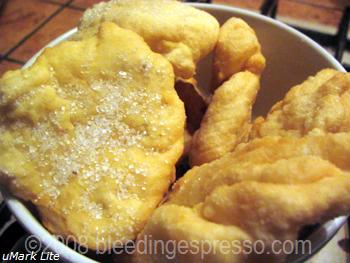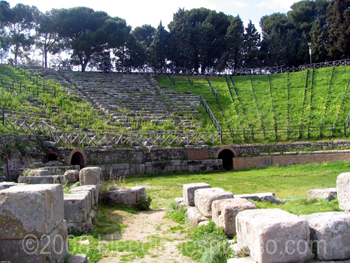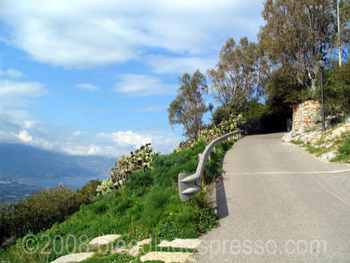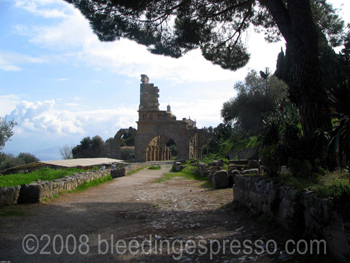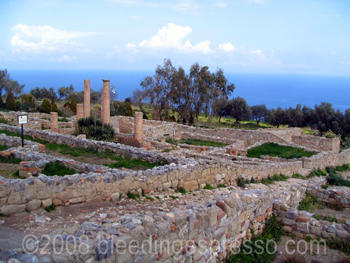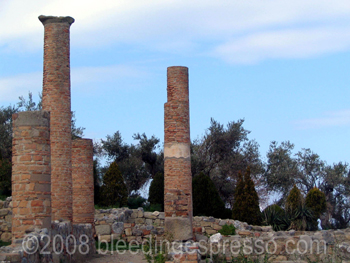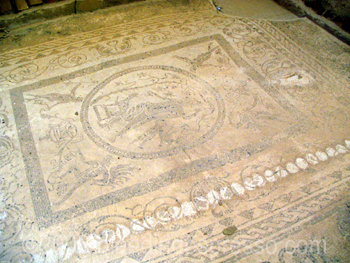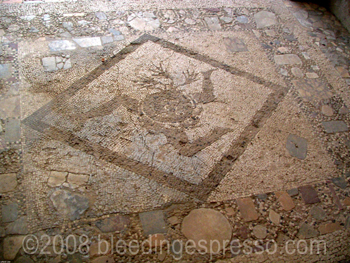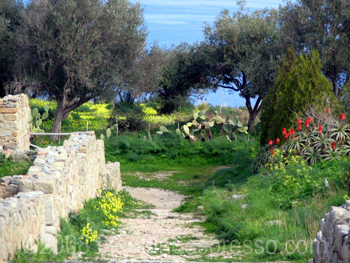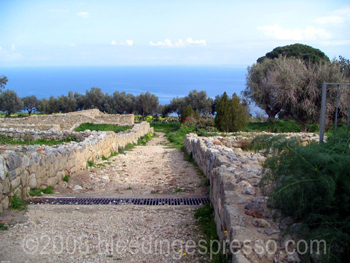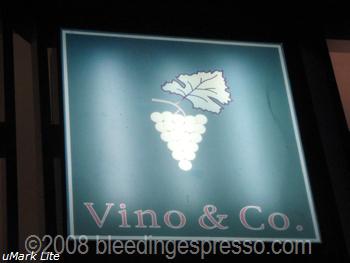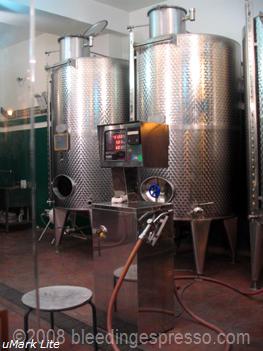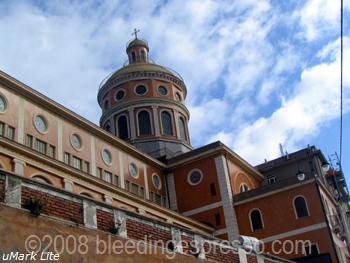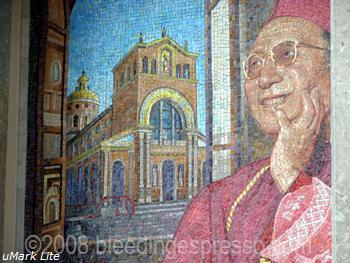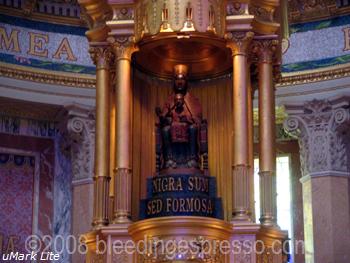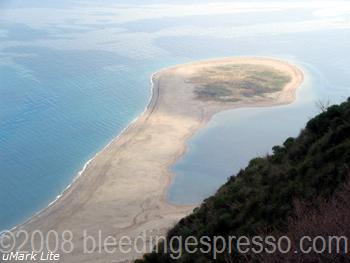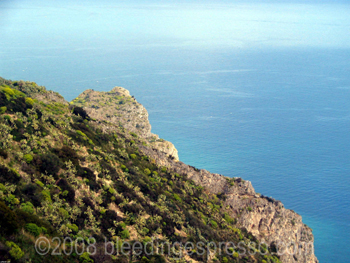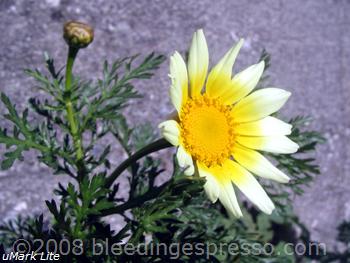Archive for the ‘uniquely italian’ Category
What’s Cooking Wednesday: Calabrian Zeppole for St Joseph’s Day
 Happy St. Joseph’s Day! And to my dad, Happy Italian Father’s Day!
Happy St. Joseph’s Day! And to my dad, Happy Italian Father’s Day!
Perhaps you’re confused. That’s OK. You can read all about the Festa di San Giuseppe in last year’s post: Fava Beans and Cream Puffs. There you’ll also find a photo of my great-great-grandfather a.k.a. the reason I ended up in my charming village.
Auguri Papù and to all Josephs, Giuseppes, and dads out there!
Also to Giuseppinas, Josephines, and any others celebrating!
Also, if some of you happen to remember St. Joseph’s Day altars from childhood but are missing them right about now, check out this Virtual St. Joseph’s Day Altar. If you don’t have any idea what I’m talking about, read about this tradition.
Now . . . it’s time for zeppole.
Or as we say around here, zippoli.
As I noted in last year’s post, this word means many different things depending on where in Italy you are. This is a common phenomenon, and in fact, just last night I read a similar sentiment in Laura Schenone’s The Lost Ravioli Recipes of Hoboken: A Search for Food and Family:
“Prescinsêua cheese may mean one thing in the city, but to some contadini in the country it may mean something completely different.”
So, in that vein, some of you know zeppole as cream puffs, but there ain’t no cream in the Calabrian version. In fact, there are anchovies.
How’s that for una sorpresa if you’re expecting cream?
I have a very vague memory of my grandmother [perhaps] making these with anchovies when I was small, but the ones I remember best were simply coated in sugar while they were still hot.
Ah . . . zeppole memories . . .
Waiting patiently at my grandmother’s hip (seriously I was that high, or low I should say as she was under 5 feet tall) for these to cool down ever so slightly to dig in. She never got even near a platter-full before one batch was already gone. They’re that good.
Unfortunately for my recipe repertoire though, my grandmother didn’t make her own dough in her later years when kneading wasn’t possible; she always bought fresh dough from the *best* local pizzeria and bakery.
Indeed, she’d pick up the dough early Friday morning (during Lent especially), make pizzas throughout the day and then fry these babies up just as we were finishing up on the pizza. I cannot tell you how much I miss walking into that house on Friday afternoons after school.
MAMMA MIA . . . CHE PROFUMO!
So I went to a few sources for a recipe:
(1) P’s mom; (2) my friend Alida from nearby Isca sull’Ionio who I met in Philadelphia (she brought homemade biscotti to our first in-person meeting!); and (3) my dear friend Mary Amabile Palmer’s cookbook Cucina di Calabria: Treasured Recipes and Family Traditions from Southern Italy.
Between these wonderful women (grazie mille!), I am tasting exactly what I remember swiping off paper towels as a child. And now you can enjoy them too.
Zeppole con Alici o Semplice
(I Zippoli Calabrese)
Fried Dough with Anchovies or Plain
- 1 package active dry yeast or 10 g of fresh yeast
- 1 1/4 cups warm water
- 3 cups all-purpose or “00” flour
- 1/2 teaspoon salt
- Splash of white wine
- 1 small jar or can of anchovies
- vegetable oil for frying
- confectioner’s or regular sugar for dusting (if making plain version)
1. Dissolve yeast in 1/4 cup of warm water.
2. Put salt and flour in a mound on your working space, a wooden board if possible, although I use something like this like my grandmother used.
3. Make a well in the center and gradually add the dissolved yeast, remaining water, and wine pulling flour into the liquid as you go.
4. Knead for between 5 and 10 minutes until the dough is smooth, elastic, and “bella morbida” as my suocera kept saying–quite soft. If you’re used to making pizza, you may have recognized these ingredients; just make sure the dough here is softer than for pizza.
5. Put dough ball in oiled bowl, cover it with a towel, and put in a dry, warm place to rise for about 2 hours.
6. After the dough has doubled in size, take it out, and knead it for another few minutes. Then put it back in the bowl and allow it to rise again for another couple hours. This will make for fluffier zeppole, but if you don’t have time, just let it rise once. They’ll still be good.
7. In the meantime, if you’re using anchovies, prepare them by removing them from their container and draining oil. Cut them in two pieces so that they will fit into a pocket of dough that will end up being about the size of the palm of your hand once folded over.
8. Heat oil over medium heat.
9. Pull off small chunks of dough about golf-ball size, flatten, and stretch into a rectangle. Place anchovy or two inside and fold over, sealing edges well. If you’re making the plain version, simply stretch to dough to the size of the palm of your hand.
10. Fry in hot oil for 3 to 4 minutes, turning zeppole so they are lightly brown all sides.
11. Remove from oil with slotted spoon and place on paper towels to drain.
12. If you are making them without anchovies, dust them with sugar while they’re still hot–and if you’re like me and actually like the anchovy-filled ones with sugar as well (ssh–they think I’m very weird here for this), go right ahead!
Note you can also fill these with lots of other things. Raisins, for example, are delicious inside and then I recommend dusting with confectioner’s sugar.
Buon appetito!
The Ruins of Tindari, Sicily
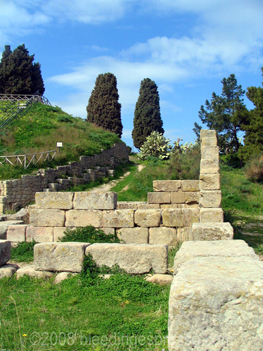 We’ve visited the Sanctuary of the Black Madonna in Tindari, and now it’s time to tour the ruins.
We’ve visited the Sanctuary of the Black Madonna in Tindari, and now it’s time to tour the ruins.
Tindari, ancient Tyndaris, is about 60 km from Messina and sits above the Tyrrhenian Sea with views of the Gulf of Patti and the Cape of Milazzo, a fabulous strategic position to control the waters between the Aeolian Islands and Messina back when there where pirates and whatnot.
Tyndaris was originally settled in 1500 B.C. but Dionysius I of Syracuse turned the settlement into a full-fledged Greek city in 396 B.C.
Tindari then came under control of the Romans in 254 B.C., after which most of the Greek infrastructure was modified or simply built over to accommodate the prospering city.
Other major events in the city’s history include an earthquake in 365 A.D., a landslide at the end of the 1st century A.D., and the construction of the Sanctuary of the Black Madonna sometime before the Saracens invaded the city in the 9th century.
By the 19th century, Tindari was abandoned, leaving behind only the Sanctuary and the ruins. Ready to see what’s left?
Here is the Greek amphitheater built in the 4th century B.C. and later modified by the Romans:
This once hosted some spectacular gladiator battles, but now it is home to the Tindari Estate (Summer) Festival. From late July through the third week of August, the old theater is full of life with poetry, music, dance, and play performances.
Incidentally, over the years, the theater was disassembled to make city walls, some of which are still in place; this is the walk up to the ruins with some of the old stones visible on the lower left:
The site also contains the remains of an old basilica that, again, was erected by the Greeks in the 4th century B.C. but has been modified over the years, and even partially restored quite recently.
And then there’s everything else–remains of baths, houses, schools, and other buildings.
And the mosaics–can’t forget the mosaics.
Here is the Sicilian symbol “Trinacria.”
There are also animal mosaics–a fabulous bull and goat if you’re interested.
The complex also houses an Antiquarium–a museum that stores some of the treasures found at the site:
Doesn’t he remind you of my muse, Leonardo?
I could’ve spent *much* more time here, absolutely enveloped in peace and calm. The natural surroundings here are just amazing:
Between the ruins, the Sanctuary of the Black Madonna, and the gorgeous scenery, Tindari is simply a must-stop if you’re traveling through this part of Sicily.
Bring a picnic lunch and allowing yourself plenty of time to daydream.
Check out my Sicily 2008 Flickr collection for lots more photos of Tindari!
Celebrating St. Patrick with Vino & Co. in Palermo, Sicily
Today is the day when the Irish all over the world celebrate the patron saint of Ireland, St. Patrick.
Italia’s day is coming soon (Wednesday for San Giuseppe to be exact), but far be it from me not to join in the festivities with my Irish brothers and sisters.
After all, I may be just a wee bit Irish as I had a great-great-grandmother by the name of Maggie Kennedy.
I’m not into the green beer thing, I’m afraid, but I will offer up some vino for the occasion; how about a fabulous red from Vino & Co. in Palermo, Sicily?
I personally can’t think of a better excuse to take an empty 5-liter jug and head to a filler station like this one.
This was just a few minutes from our hotel, but unfortunately, Cherrye and I didn’t plan ahead and bring a container large enough–no regular old plastic bottles allowed.
But back to the green-themed day, I also found this page for those of you in need of some last minute party supplies that will also make you laugh as you’re browsing. The faces on some of these models are just hilarious.
And, I guess, effective because a lot of this stuff is actually sold out. Go figure.
Happy St. Patrick’s Day to those celebrating!
The Sanctuary of the Black Madonna in Tindari, Sicily
* Have you joined The Ultimate Blog Party? See my welcome post here! *
We’re back in Sicily today, dear readers, to visit Tindari (Tyndaris), an ancient Greek settlement in the comune of Patti.
I’ll tell you more about the history of this once vibrant city overlooking the Tyrrhenian Sea another day when we tour the ruins of Tindari, but today’s feature is the Sanctuary of the Black Madonna (Santuario della Madonna Nera).
The original church, which had been built on top of the old city’s ruins, was destroyed by Algerian pirates in 1544, then reconstructed between 1552 and 1598; the sanctuary was expanded in 1979 when a new, larger church was built on the site.
The whole grounds are just lovely; indeed, here is a fabulous mosaic that you’ll see on the walk up to the church doors. I don’t know who he is, but he sure looks peaceful and content, doesn’t he?
I should mention that the phenomenon of Black Madonnas around the world is interesting in and of itself, and you can read more about it here.
The Black Madonna in Tindari, carved of cedar, has a few legends attached to her, some of which include how she got there in the first place.
One legend says that sailors, having sought refuge from a storm in the bay of Tindari, found themselves unable to ship back out to sea.
They began unloading their cargo little by little until they realized that it was the Black Madonna herself that needed to stay in Tindari, so they carried her up to the small church on the hill, and she has remained there ever since.
Another legend says that the statue was brought from the Middle East (its likely origin regardless of how it ended up in Tindari) to protect Sicily during the Iconoclastic Wars in the 8th century.
And these aren’t the only legends surrounding the Black Madonna. See this lagoon?
It is said to have been created when a mother coming to visit the sanctuary refused to pray to the Madonna because she was black. When the woman’s baby slipped from her grasp into the sea below, the Madonna made parts of the land rise to save the baby and the lagoon was born.
Another interesting feature of the Madonna Nera is the inscription “Nigra sum sed formosa” at the base of the statue. It means “I am black but beautiful” and comes from the Old Testament’s Song of Songs, although the precise relationship between the biblical phrase and the Black Madonna is widely debated.
Some of you from the New York/New Jersey area may have already heard of the Black Madonna of Tindari as Sicilian immigrants have honored her since the early 20th century–for more information on this connection, check out a great article by Joseph Sciorra discussing the history of The Black Madonna of East Thirteenth Street as well as a short piece from The New York Times.
And, before we go, another gorgeous view looking down from the Sanctuary:
Pure tranquility and beauty in Tindari.
I highly recommend a visit.
Dreaming About the Meaning of Life
I had a different post planned for today (come back tomorrow for more Sicilian adventures–sneak preview in my Flickr set!), but this morning I woke up after having a most interesting exchange with a random bearded man in un sogno–a dream.
In italiano.
We were in a souvenir store, and he was near the back listening to my conversation with the woman clerk about what I’m doing in Calabria.
He walked towards us, rubbing his hands together, turned to me, and said:
Cara signorina, mi dice, tra un Papa e un povero,
chi passa la vita migliore?
[Dear miss, tell me, between a Pope and a poor man,
who lives the better life?]
I paused, looked up to my left then into his dark eyes, and responded:
Caro Signore, questa non è la domanda.
La domanda è . . . chi ha apprezzato la vita di più?
[Dear sir, that’s not the question.
The question is . . . who has appreciated life more?]
When I told P about my dream and he said simply, “Hai risposto giusto.”
You answered correctly.
With all of this churning through my head, I took off for my morning walk with the pooches, and guarda!
The first margherita of the season:
Life is good.
Have a fabulous week my peeps.

